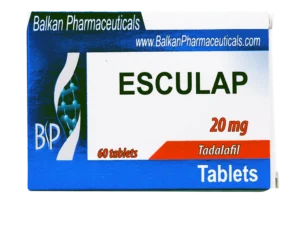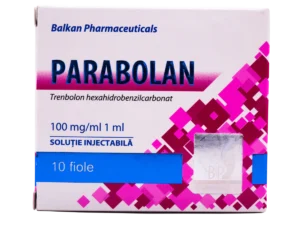Exedrol Tablets 25 mg
The International Common Name (ICN) of the active substance
Exemestanum
COMPOSITION OF PREPARATION
1 tablet contains
The active substance: Exemestane 25 mg;
Excipients: Magnesium stearate, Kollidon CL (crospovidone), FD & C Blue dye no. 1, Ludipress® (lactose, polyvidone, crospovidone).
PHARMACEUTICAL FORM
Tablets.
PREPARATION DESCRIPTION
Blue tablets of square shape, flat top and bottom, flat edges with one line on one side and “BP” inlay, on the other side with the inscription “25”, the side with rounded edges. A marble is allowed on the surface of the tablets.
THE PHARMACOTERAPEUTICAL GROUP and the ATC Code
Hormonal antagonist. Enzymatic inhibitor. COD ATC: L02B G06.
-
-19% Out of stock
 Balkan Pharmaceuticals
Balkan Pharmaceuticals
PHARMACOLOGICAL PROPERTIES
Pharmacodynamic properties
Exemestane is an irreversible steroidal aromatase inhibitor, structurally related to the natural substrate, androstendione. In postmenopausal women, estrogens are mainly produced in peripheral tissues by the conversion of androgen into estrogen by aromatase. Deprivation of estrogens by aromatase inhibition is an effective and selective treatment of hormone-dependent mammary neoplasm in postmenopausal women. In postmenopausal women, oral exemestane significantly decreased estrogen levels starting at a dose of 5 mg with a maximum suppression
(> 90%) at a dose of 10-25 mg. In postmenopausal breast cancer patients treated with a daily dose of 25 mg, the effect of whole body aromatase was reduced by 98%.
Exemestane does not exhibit progestogenic or estrogenic activity. Especially at high doses, a mild androgenic activity was probably due to the 17-hydroderivative. In clinical trials with repeated daily doses, exemestane did not show detectable effects on cortisol or aldosterone biosynthesis of the adrenal glands, measured before or after the ACTH challenge test, thus demonstrating its selectivity against other enzymes involved in the synthesis of steroid hormones.
Therefore, substitution therapy with glucocorticoids or mineralocorticoids is not necessary. A slight, dose-independent increase in serum LH and FSH levels has been observed even at low doses: this effect is however predictable for this class of drugs and is probably the result of pituitary feedback the decrease in estrogen concentration that stimulates the pituitary secretion of gonadotropins and in postmenopausal women.
Adjuvant treatment of early breast cancer.
Pharmacokinetic properties
Absorption
After oral administration of exemestane tablets, the drug is rapidly absorbed. The amount of drug absorbed in the gastrointestinal tract after dosing is high. Absolute bioavailability in humans is not known, although it is anticipated to be limited by large-scale metabolism in the first passage of the liver. After a single 25 mg dose, the maximum plasma concentration of
18 ng/ml is reached 2 hours after dosing. Concomitant administration with food increases bioavailability by 40%.
Distribution
Plasma protein binding is 90% and is not concentration dependent. The elimination half-life is 24 hours. Exemestane and its metabolites do not bind to the red blood cells.
Metabolism and excretion
Exemestane is metabolised by oxidation of the 6-position methylene group by the CYP3A4 isoenzyme and/or reduction of the 17-keto group by aldocetoreductase followed by conjugation. The clearance of exemestane is of approximately 500 l/h, uncorrected depending on bioavailability after oral administration. Metabolites are inactive or aromatase inhibition is lower than that of the non-metabolised drug. The amount of unchanged drug in the urine is less than 1% of the administered dose. In urine and feces, approximately equal (40%) of radiolabeled exemestane with 14 ° C were removed within one week.
Special patient groups
Age
No significant correlations between systemic exposure to exemestane and the age of subjects were observed.
Kidney failure
In patients with severe renal impairment (CLcr <30 ml / min), systemic exposure to exemestane was twice as high as healthy volunteers. Due to the safety profile of exemestane, no dose adjustment is required.
Hepatic impairment
In patients with moderate or severe hepatic impairment, exposure to exemestane was 2-3 times higher compared to healthy volunteers. Due to the safety profile of exemestane, no dose adjustment is required.
THERAPEUTICAL INDICATIONS
Exemestane is indicated in the adjuvant treatment of early stage invasive breast cancer with estrogen receptors in postmenopausal women after 2-3 years of tamoxifen initially adjuvant therapy. Exemestane is indicated for the treatment of advanced breast cancer in physiologically or induced postmenopausal women whose disease has progressed as a result of anti-estrogen therapy.
DOSES AND METHOD OF ADMINISTRATION
The recommended dose of exemestane is one tablet (25 mg) given once a day after a meal.
In patients with early breast cancer, treatment with exemestane should be continued until 5 years of sequential combined hormonal treatment (tamoxifen followed by exemestane) or more early if tumor recurrence occurs.
In patients with advanced breast cancer, treatment with exemestane should be continued until tumor progression is diagnosed.
SIDE EFFECTS
Exemestane was generally well tolerated in all clinical trials with exemestane at a standard dose of 25 mg / day, and the reactions various were generally mild to moderate.
The reported side effects are listed below, classified by system organ class and by frequency. Frequencies are defined as: very common (≥ 1/10), common (≥ 1/100 and <1/10), uncommon (≥ 1/1000 and <1/100), rare (≥ 1/10000 and < 1/1000), very rare (<1 / 10,000), not known (can’t be estimated from the available data).
Blood and lymphatic disorders: Rare-thrombocytopenia, leukopenia.
Metabolism and nutrition disorders Common – anorexia.
Psychiatric disorders: Very common – insomnia, Common – depression.
Nervous System Disorders: Common – headache, Uncommon – drowsiness.
Vascular disorders: Very common – hot flashes.
Gastrointestinal disorders: Very common – nausea, Common – abdominal pain, vomiting, constipation, dyspepsia, diarrhea, gastric ulcer.
Hepato-biliary disorders: Uncommon – increased liver function, increased enzymes, ilirubin, alkaline phosphatase, hepatitis.
Skin and subcutaneous tissue disorders: Very common – hypersexposure, frequent-rash, alopecia.
Musculoskeletal and bone disorders: Very common – joint and muscular pain, Common – osteoporosis, fractures.
General disorders at the site of application: Very common – fatigability, Uncommon – asthenia.
CONTRAINDICATIONS
Exemestane is contraindicated in patients:
– with known hypersensitivity to the active substance or to any of the excipients, to premenopausal and pregnant women or to breastfeeding women.
OVERDOSE
Clinical studies have been performed with single doses of up to 800 mg exemestane in healthy female volunteers and doses up to 600 mg daily in postmenopausal women with advanced breast cancer; these doses were well tolerated. There is no known single dose of exemestane that may cause life-threatening symptoms. In rats and dogs, lethality was observed after a single oral dose equivalent to 2000 or 4000 times the recommended human dose expressed in mg/m2. There is no specific antidote in case of overdose, and the treatment should be symptomatic. General supportive measures, including frequent monitoring of vital signs and close monitoring of the patient, are recommended.
WARNINGS AND SPECIAL PRECAUTIONS FOR USE
Exemestane should not be administered to premenopausal women. Therefore, when clinically necessary, postmenopausal status should be confirmed by assessing plasma levels of LH, FSH and estradiol.
Exemestane should be used with caution in patients with renal or hepatic impairment.
Exemestane is a powerful drug that lowers the estrogen concentration; the decrease in bone mineral density and the incidence of fractures due to exemestane administration were observed. During excipient treatment with exemestane, bone mineral density should be determined in women with osteoporosis or at risk of osteoporosis by using DEXA (X-ray osteodensitometry) at the start of treatment. Although no adequate data are available to demonstrate the effects of bone mineral reduction treatment following exemestane treatment, treatment of osteoporosis should be initiated in patients at risk. Patients treated with exemestane should be closely monitored. Exedrol tablets contain lactose. Patients with rare hereditary problems of galactose intolerance, Lapp lactase deficiency (Lapp), or glucose-galactose malabsorption should not take this medicine.
Pregnancy and breastfeeding
No clinical data on exposed pregnancies are available for exemestane. Studies in animals have shown reproductive toxicity. Therefore, exemestane is contraindicated in pregnant women.
It is not known whether exemestane is excreted in human milk. Exemestane should not be given to women who are breast-feeding women in perimenopause or fertile age.
The attending physician should discuss the need for appropriate contraceptive methods in women who may become pregnant, including women in perimenopause or who have recently entered postmenopause, until their postmenopausal status is fully established.
Effects on ability to drive and use machines
In the process of using the drug there have been reports of weakness, dizziness and drowsiness. Patients should be advised, that if these reactions occur adverse, physical and/or intellectual ability to drive or use machines can be affected.
INTERACTIONS WITH OTHER MEDICINES, OTHER TYPES OF INTERACTION
In vitro studies have shown that the drug is metabolised via the CYP 3A4 isoenzyme of cytochrome P450 and aldocetoreductases and does not inhibit any important CYP isoenzyme.
In a pharmacokinetic clinical study, specific inhibition of CYP 3A4 by ketoconazole did not cause significant effects on the pharmacokinetic profile of exemestane.
In a study on interactions with rifampicin, a potent CYP450 inducer following 600 mg rifampicin/day and a single dose of exemestane 5 mg, exemestane AUC was decreased by 54% and Cmax by 41%. Because the clinical relevance of this interaction has not been evaluated, concomitant medication such as rifampicin, anticonvulsants (eg phenytoin and carbamazepine) and herbal preparations Hypericum perforatum (St. John’s wort), known inducers of CYP 3A4, may decrease the efficacy of exemestane.
Exemestane should be used with caution in combination with medicinal products that are metabolised by CYP 3A4 and have a narrow therapeutic index. There is no clinical experience with concomitant use of exemestane and other antineoplastic agents.
Exemestane should not be used concomitantly with estrogen-containing medicines because they cancel out the pharmacological action of exemestane.
PRESENTATION, PACKAGING
25 mg tablets.
Twenty (20) tablets in blister, three (3) blisters together the instruction for administration is placed in a cardboard box.
STORAGE
Keep at temperatures below 25 °C.
Do not freeze.
Store in the original package in order to protect from light and moisture.
Keep out of the reach and sight of children.
TERMS OF VALIDITY
Three (3) years.
Do not use after the expiry date stated on the pack!
LEGAL STATUS
It is issued with prescription.
CERTIFICATE OF REGISTRATION
SC Balkan Pharmaceuticals SRL N. Grădescu str., 4, MD-2002, or. Chisinau, Republic of Moldova.
The manufacturer
SC Balkan Pharmaceuticals SRL Industrial Street, 7 / A, MD-2091, or. Singera, Republic of Moldova.
This product you can buy here.










